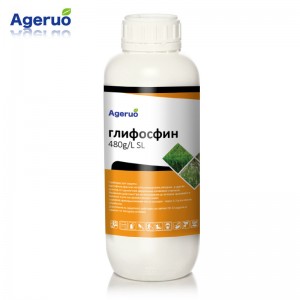Glyphosate 480g/L SL can be mixed with some herbicides to improve the effect of weed control, expand the spectrum of weed killing or solve the problem of resistance, etc. However, it should be noted that the specific formulation should follow certain principles and should be chosen according to the actual situation and the target weeds. However, it should be noted that the mixing of herbicides needs to follow certain principles, and the specific mixing formulations should be selected according to the actual situation and the target weeds, and at the same time, attention should be paid to avoid the occurrence of drug damage.
Related reading: 2, 4-D metsulfuron methyl or glyphosate: What’s the difference?
The following are some common glyphosate mixing formulations:
Glyphosate + Acetochlor + Atrazine: The mixture of the three can not only prevent and eliminate a variety of weeds that have emerged, but also achieve the effect of soil closure for weed control. For perennial weeds, it can also kill their root system by improving the control effect of glyphosate to achieve the purpose of eradication.
Glyphosate + Acetochlor + bensulfuron-methyl: Glyphosate has outstanding preventive effect on common annual and perennial weeds, but its preventive effect is a little bit poorer on some broad-leaved weeds such as leguminous weeds, and mixing with a small amount of bensulfuron-methyl has the effect of synergizing, which can enlarge the weed-killing spectrum.
Glyphosate + MCPA-sodium: MCPA-sodium mixed with glyphosate increases the absorption and transportation of glyphosate when preventing broad-leaved weeds, it has fast and good effect on broad-leaved weeds, broad-leaved weed irrigation, etc. Especially, it has better effect on Tianhuanhua and Taibaohua, and it does not affect the preventive effect on gramineous weeds.
Glyphosate + Fluoroglycofen: Fluoroglycofen has a shorter half-life and can be degraded completely faster, so it is less restricted by the number of times when spraying directionally between the crop rows and is suitable for use in no-tillage. This formula is special effect on amaranth, etc., and also has synergistic effect on general broadleaf, without affecting the prevention effect on graminaceous, applicable to vegetable fields, etc.
Glyphosate + quizalofop-p-ethyl: It is effective on grass weeds, especially on rooted perennial malignant weeds, without affecting the prevention effect on broad-leaved weeds.
Glyphosate + fluroxypyr: the mixture of the two can expand the spectrum of grass-killing, and has a significant synergistic effect on hollow lotus grass and water peanut.
Glyphosate + Bentazon: the mixture can expand the weed-killing spectrum, and at the same time, it has good synergistic effect, and can significantly improve the prevention effect on Abutilon grass.
Glyphosate + sulfometuron-methyl: the mixture of glyphosate and sulfometuron-methyl can overcome the shortcomings of slow efficacy of sulfometuron-methyl and glyphosate with no persistence period, and the general preventive effect of leguminous weeds, which can be sprayed on stems and leaves and effectively prevent and eliminate the aboveground weeds, and can be closed to the soil and be absorbed by the roots of the plant and the young shoots of the weeds, and effectively control the germination and seedling growth of the plant in the soil, and it can be used in the treatment of the soil. It can effectively control the germination of plant seeds and seedling growth in the soil, reduce the dosage of sulfometuron-methyl, and reduce the residue in the field. It has broad spectrum of herbicide, both stem and leaf and soil effects, and long persistence period, but this formula is strictly prohibited to be used in arable land.
Glyphosate + Pyraflufen-ethyl: the mixture of the two can expand the weed-killing spectrum and improve the speed and effect of weed-killing. For broad-leaved grasses, glyphosate + Pyraflufen-ethyl has good quick-acting effect, but it may affect absorption; while for grass weeds, glyphosate + Pyraflufen-ethyl has more thoroughness than the same dosage of glyphosate, which has the features of fast weed-killing speed, no rebound, good root-killing performance, and fast decomposition in the soil.
When making herbicide mixing, you need to pay attention to the following points:
Strictly master the matching ratio and application time and spraying technology.
Consider whether there is any resistance between each other or other side effects, you can first take a small amount of mixability test, if there is precipitation, flocculation, delamination, floating and deterioration, etc., indicating that its safety has changed, it can not be mixed.
Pay attention to the synergistic function of mixing agent, and reduce the dosage of mixing agent (generally within half of the dosage of each single agent) when using, so as to avoid drug damage and ensure the safety of crops.
Glyphosate is an inactivating herbicide, when using it, pay attention to directional spraying, do not spray to other crops.
In addition, the use of herbicides needs to take into account specific crops, weed species, soil conditions and other factors. It is recommended to read the product instructions carefully before use and follow the advice of your local agricultural technical department or professional.
Post time: Jul-29-2024





